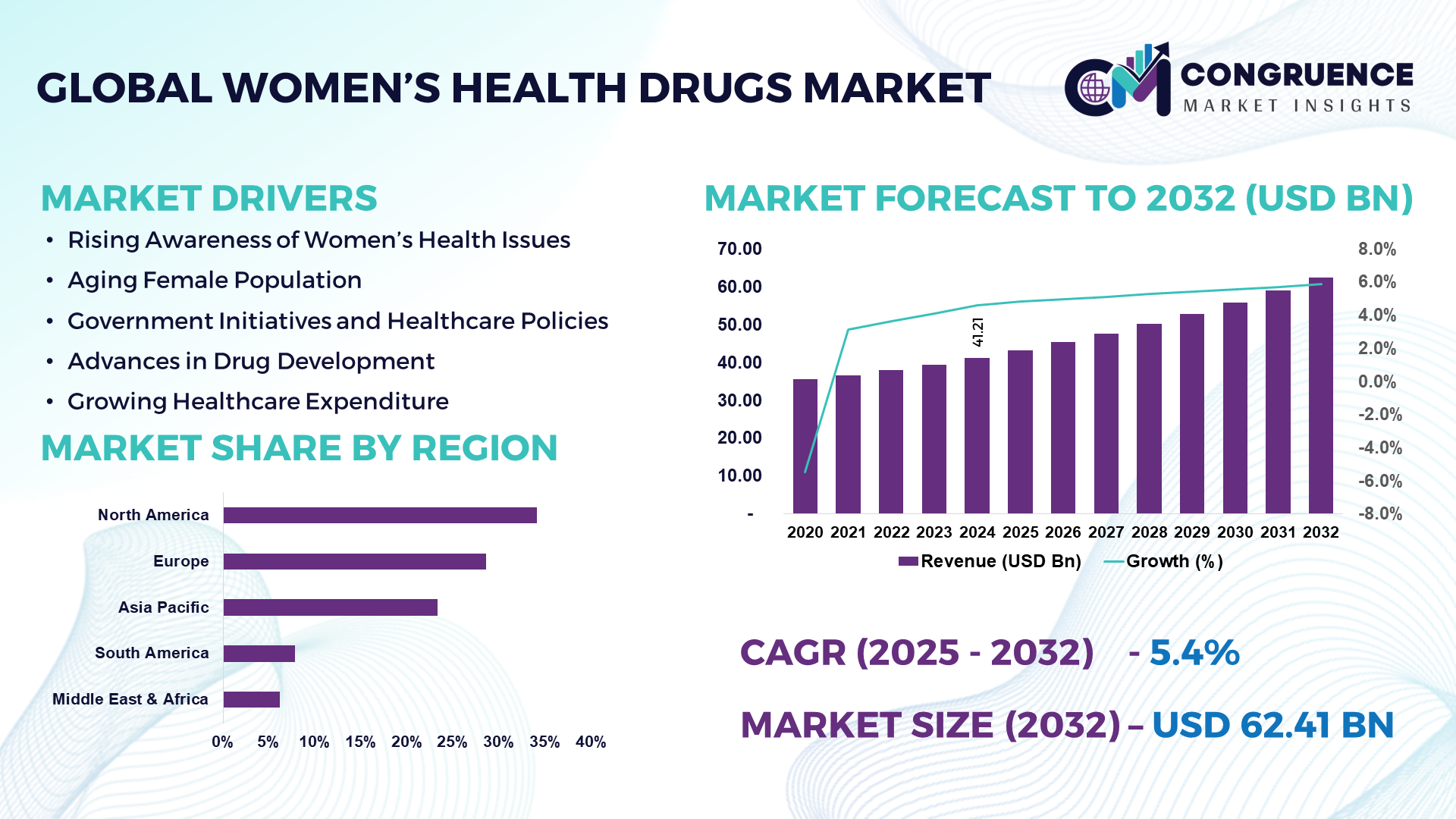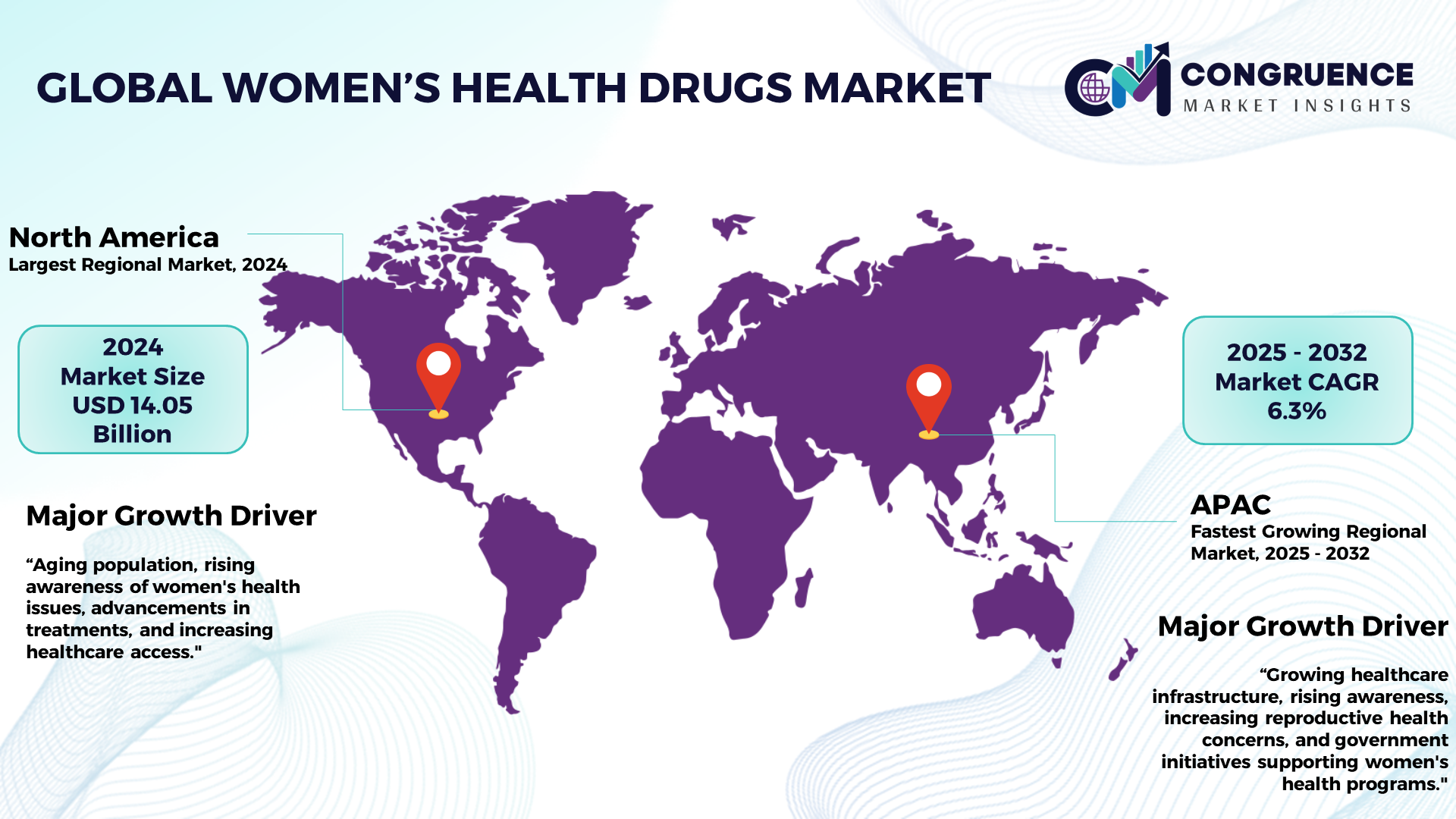Reports
Women’s Health Drugs Market Size and Forecast 2025 to 2032
The Global Women’s Health Drugs Market was valued at USD 41.21 Billion in 2024 and is anticipated to reach a value of USD 62.41 Billion by 2032 expanding at a CAGR of 5.4% between 2025 and 2032. Rising awareness of women's health issues, greater government initiatives, and a growing emphasis on preventative healthcare all contribute to market growth.

To Learn More About This Report, Request A Free Sample Copy
The Women's Health Drugs Market is quickly rising as the growing emphasis on female-specific healthcare issues fuels demand for innovative treatment solutions. With increased awareness of women's health issues, there is a greater emphasis on treating hormonal imbalances, osteoporosis, endometriosis, and menopausal difficulties. Advances in drug discovery, regulatory support, and increased global availability of healthcare resources are key factors driving market expansion. In recent years, there has been a significant trend toward personalized healthcare and preventive treatment techniques for women's health. Governments and healthcare groups around the world have developed a variety of projects to improve women's healthcare access. The need for fresh treatment choices, along with an aging female population, is driving pharmaceutical companies to create new medications. As demand for improved women's health care develops, so will the market for women's health pharmaceuticals, creating major potential for important companies.
How AI is Transforming Women’s Health Drugs Market
Artificial intelligence (AI) is transforming the women's health pharma market by allowing for improved disease management, tailored medicine, and more efficient drug discovery processes. AI-powered solutions are being used to provide focused therapeutics for complicated women's health diseases such as endometriosis and menopause-related symptoms, which have historically been difficult to treat. AI can use modern data analytics to assess patient histories, genetic information, and clinical outcomes in order to offer individualized treatment alternatives, hence enhancing patient care and success rates. AI is also speeding up the drug research process in the women's health industry. Machine learning algorithms can sift through large datasets to uncover possible drug candidates more quickly, considerably lowering the time and expense of drug development. This is especially useful for companies seeking to address unmet needs in women's health, such as developing novel medicines for reproductive health disorders. Furthermore, AI improves diagnosis and early detection of diseases such as ovarian and breast cancer. AI-powered imaging technologies and prediction models allow healthcare providers to diagnose diseases early, resulting in a better prognosis and more prompt interventions. As AI technologies advance, they will play a critical role in revolutionizing how women's health issues are monitored and treated worldwide.
Women’s Health Drugs Market Major Driving Forces
· Increased Awareness of Women's Health Issues: The growing global knowledge of women's health issues, such as hormone imbalances, reproductive health, and menopause, is driving the desire for novel healthcare approaches.
· Aging Female Population: As the world's population ages, the prevalence of health conditions such as osteoporosis, menopause, and post-menopausal difficulties rises, increasing demand for specialized women's health medications.
· Government Initiatives and Healthcare Policies: Many government programs aimed at improving women's healthcare, particularly in emerging nations, are pushing greater access to healthcare facilities and treatments.
· Advances in Drug Development: Innovations in pharmaceutical research, such as the development of non-hormonal medicines for menopause and reproductive health, are propelling market expansion by meeting unmet medical requirements.
· Growing Healthcare Expenditure: Increased healthcare spending by governments and people, particularly in developed nations, is allowing for more access to high-quality women's health pharmaceuticals and treatments.
Women’s Health Drugs Market Key Opportunities
· Preventive Care Expansion: With a growing emphasis on preventive healthcare, pharmaceutical companies have a great chance to create medications that help avoid prevalent women's health conditions such as osteoporosis and hormone abnormalities.
· Personalized Medicine: Advances in personalized medicine allow us to tailor treatments to the specific needs of female patients, providing more effective solutions for issues including reproductive health and menopause.
· Online Pharmacies and Telemedicine: The growing popularity of online pharmacies and telemedicine platforms is opening up new distribution channels for women's health medications, particularly in distant or underserved areas where access to healthcare is limited.
· Non-Hormonal Therapies: There is a growing need for non-hormonal treatments for illnesses such as menopause and endometriosis. Pharmaceutical businesses that focus on creating non-hormonal medicines have the opportunity to obtain a competitive advantage in the market.
· Expansion in Emerging Markets: Rapid economic expansion in Asia and Latin America is creating new opportunities for women's health medicine makers.
Women’s Health Drugs Market Key Trends
· The demand for non-hormonal treatments, particularly for conditions such as menopause and osteoporosis, is increasing due to concerns over side effects associated with hormone replacement therapy (HRT).
· There is an increasing interest in individualized treatments for women's health, particularly for treating reproductive health disorders and hormone imbalances. This transition is being driven by advances in genomics and precision medicine.
· Preventive healthcare methods, such as early screenings and interventions for osteoporosis and cancer, are becoming more frequent, resulting in increased demand for pharmaceuticals that promote long-term health.
· With the advent of telehealth services and online pharmacies, women's health medications are becoming more accessible, especially in rural or underserved areas.
· Natural and organic health products are becoming increasingly popular, particularly for menopause and hormonal balance treatments.
Region-wise Market Insights
North America accounted for the largest market share at 34.1% in 2024 whereas, Asia Pacific is expected to register the fastest growth, expanding at a CAGR of 6.3% between 2025 and 2032.

To Learn More About This Report, Request A Free Sample Copy
North America topped the women's health medicines market in 2024. The region's leadership is fueled by strong healthcare infrastructure, improved awareness of women's health issues, and high healthcare spending. Menopause and reproductive health therapies are in high demand in the United States, owing primarily to an aging population and an increasing emphasis on preventative care.
· In August 2024, Bayer submitted a New Drug Application to the U.S. FDA for elinzanetant, a non-hormonal treatment for moderate to severe vasomotor symptoms (hot flashes and night sweats) associated with menopause. This move is part of Bayer's broader commitment to addressing women's health needs. Elinzanetant aims to provide relief without the use of hormone replacement therapy, offering a new option for menopause management.
Asia Pacific is predicted to have the fastest growth rate between 2025 and 2032. Improving healthcare infrastructure, increasing internet penetration, and raising awareness of women's health in growing economies such as China and India are all factors driving expansion. Furthermore, increased healthcare spending and government measures to improve women's healthcare access are likely to drive demand for women's health medications in the region.
Europe is emphasizing the development of non-hormonal medicines and preventative care, notably in Western European countries such as Germany, France, and the United Kingdom.
Latin America, the Middle East, and Africa are experiencing significant investment in healthcare infrastructure, with more opportunity to provide specialist women's health treatments.
Recent Developments
· In January 2024, Bayer announced that its experimental drug elinzanetant succeeded in two late-stage trials for treating menopausal hot flashes. The trials showed a reduction in the frequency and severity of vasomotor symptoms, as well as improved sleep and quality of life for postmenopausal women. Bayer plans to submit data from a third Phase III trial for regulatory approval later this year, aiming to capture a share of the growing market for non-hormonal menopause treatments.
· In August 2022, Pfizer and Myovant Sciences received U.S. FDA approval for MYFEMBREE, a once-daily pill for managing moderate to severe endometriosis pain. Clinical data supported its approval, and it is available for treatment of pre-menopausal women.
· In February 2020, Merck & Co. announced plans to spin off its women’s health, biosimilar drugs, and legacy products into a new publicly traded company. The move allows Merck to focus on its more profitable ventures, including cancer drugs such as Keytruda, vaccines, and hospital and animal health businesses. This restructuring aligns with Merck's strategy to sharpen its focus on its core operations.
Market Competition Landscape
The global women's health medicines industry is fiercely competitive, with key competitors focused on growing their portfolios, increasing R&D efforts, and forming strategic alliances. Pfizer, Merck & Co., Bayer AG, and Novartis AG are among the industry's key players, offering a wide range of medications aimed at reproductive health, hormonal treatments, and illnesses such as osteoporosis and menopause. New entrants and specialized biotech companies are increasing competition by bringing novel remedies to specific conditions such as endometriosis, polycystic ovarian syndrome (PCOS), and postmenopausal osteoporosis. The market is also seeing more investment in artificial intelligence and digital healthcare systems to better medication discovery, patient monitoring, and individualized treatment approaches. Partnerships, mergers, and acquisitions remain popular tactics for firms looking to grow their market presence and research capacity. The increasing emphasis on women-specific health programs and personalized therapy is shaping the competitive landscape of the women's health pharmaceuticals market.
Key players in the global women’s health drugs market implement various organic and inorganic strategies to strengthen and improve their market positioning. Prominent players in the market include:
· Pfizer Inc.
· Merck & Co., Inc.
· Bayer AG
· Novartis AG
· Teva Pharmaceutical Industries Ltd.
· Allergan plc (AbbVie)
· Amgen Inc.
· Eli Lilly and Company
· Ferring Pharmaceuticals
· Mylan N.V.
· Lupin Limited
· GlaxoSmithKline plc
· AstraZeneca plc
· Novo Nordisk
|
Report Attribute/Metric |
Details |
|
Market Revenue in 2024 |
USD 41.21 Billion |
|
Market Revenue in 2032 |
USD 62.41 Billion |
|
CAGR (2025 – 2032) |
5.4% |
|
Base Year |
2024 |
|
Forecast Period |
2025 – 2032 |
|
Historical Data |
2020 to 2024 |
|
Forecast Unit |
Value (US$ Bn) |
|
Key Report Deliverable |
Revenue Forecast, Growth Trends, Market Dynamics, Segmental Overview, Regional and Country-wise Analysis, Competition Landscape |
|
Segments Covered |
· By Type (Hormonal, Non-hormonal, Reproductive Health, Osteoporosis Drugs, and Menopause Drugs) · By Application (Contraception, Hormonal Imbalance, Osteoporosis, Endometriosis, and Menopausal Conditions) · By Distribution Channel (Hospital Pharmacies, Retail Pharmacies, and Online Pharmacies) · By End-User (Hospitals, Clinics, and Ambulatory Centers) |
|
Geographies Covered |
North America: U.S., Canada and Mexico Europe: Germany, France, U.K., Italy, Spain, and Rest of Europe Asia Pacific: China, India, Japan, South Korea, Southeast Asia, and Rest of Asia Pacific South America: Brazil, Argentina, and Rest of Latin America Middle East & Africa: GCC Countries, South Africa, and Rest of Middle East & Africa |
|
Key Players Analyzed |
Pfizer Inc., Merck & Co., Inc., Bayer AG, Novartis AG, Teva Pharmaceutical Industries Ltd., Allergan plc (AbbVie), Amgen Inc., Eli Lilly and Company, Ferring Pharmaceuticals, Mylan N.V., Lupin Limited, GlaxoSmithKline plc, AstraZeneca plc, Novo Nordisk |
|
Customization & Pricing |
Available on Request (10% Customization is Free) |
